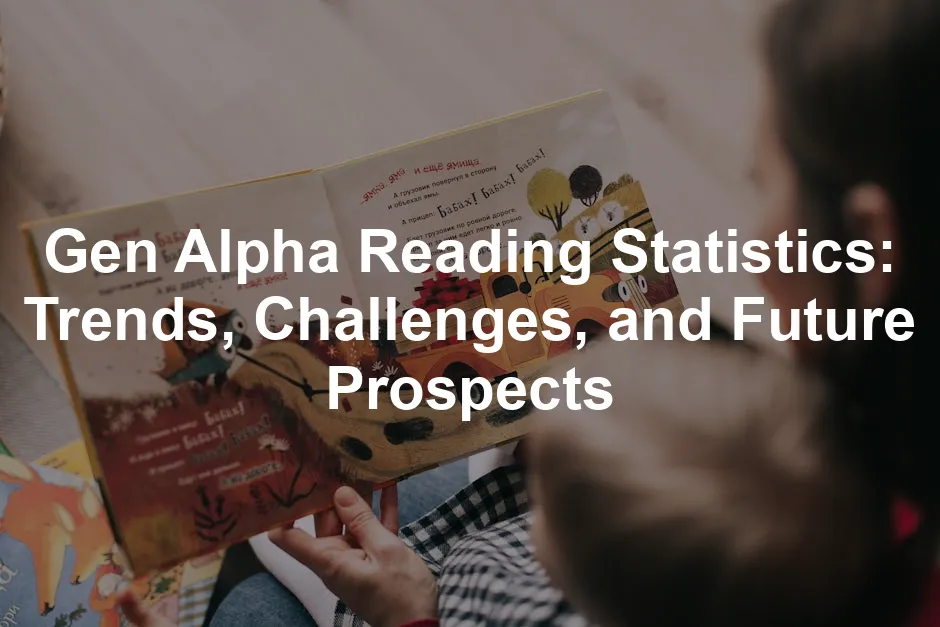Introduction
Generation Alpha, the youngest cohort born between 2010 and 2025, stands out as the first generation raised entirely in a digital landscape. These kids are growing up in a world where smartphones and tablets are as common as toys. With their Millennial parents and Gen Z siblings, they experience a reality that’s vastly different from any previous generation. The digital exposure presents unique challenges and opportunities, particularly concerning reading and literacy.
Reading is crucial for this generation. It shapes their cognitive skills, influences academic performance, and lays a foundation for lifelong learning. We know that literacy serves as a predictor of future success, especially in an information-driven society. However, the reading habits of Gen Alpha are under scrutiny. With the rise of digital media, understanding their reading statistics becomes increasingly vital for educators, parents, and society as a whole.
Understanding the reading statistics for Generation Alpha is critical for shaping effective educational strategies. reading statistics for the state of georgia
Examining Gen Alpha reading statistics holds significant implications. It informs educational strategies, parental support, and societal initiatives aimed at fostering literacy. Parents and educators alike need to understand the landscape of reading proficiency in this generation. The challenges they face can affect their long-term academic success and overall well-being. By grasping the current trends, we can better prepare for the future of Gen Alpha’s literacy development.
Speaking of reading, if you’re looking for a captivating story that combines history and imagination, check out “The Book Thief” by Markus Zusak. This novel is not just about words; it’s about the power of reading itself and how it can shape lives, especially during turbulent times.

Understanding Generation Alpha
Overview of Generation Alpha
Generation Alpha encompasses individuals born from 2010 to 2025, marking them as the first group born entirely in the 21st century. This generation is characterized by its remarkable adaptability to technology. They are tech-savvy, socially aware, and incredibly diverse. With a projected population exceeding 2 billion by 2025, they are set to be the largest generation in history. In the United States, they represent about 13% of the population, reflecting a blend of cultures and backgrounds.
The Digital Influence
Technology plays a pivotal role in shaping the upbringing of Gen Alpha. Children in this age group spend, on average, 4 to 6 hours daily on screens, according to various studies. This exposure to digital devices raises important questions about its impact on literacy. Research shows a correlation between excessive screen time and lower reading proficiency. Educational content can help, but mindless scrolling through social media may hinder attention spans and reading habits.
The average attention span for this generation is about 9 seconds, influenced by the fast-paced nature of online content. As they interact with platforms like TikTok and YouTube, the challenge for educators and parents is to ensure that reading remains an engaging and enriching activity. Balancing digital engagement with traditional reading practices is essential to fostering a love for reading in Gen Alpha.

If you’re looking for a way to make reading more engaging, consider the Kindle Paperwhite (10th Generation). With its adjustable light and vast library, it can help kids discover the joys of reading in a format they love!
Current Reading Statistics
General Literacy Trends
Generation Alpha is making waves, but not all of them are positive. Literacy rates among this generation reveal a disheartening picture when compared to their predecessors. According to the National Assessment of Educational Progress (NAEP), only about 33% of fourth graders are reading at a proficient level. This statistic mirrors levels seen decades ago, indicating a concerning stagnation in reading skills. In fact, a staggering 67% of these young ones are not proficient in reading, a trend that raises alarms among educators and parents alike.
When we look back at previous generations, such as Millennials and Gen Z, it becomes clear that Gen Alpha’s reading statistics are troubling. While earlier cohorts had literacy rates improving steadily, Gen Alpha seems to be bucking that trend. The sheer volume of screen time they absorb—averaging 4 to 6 hours daily—is likely a significant factor in this decline. With so much digital content at their fingertips, reading books has taken a back seat.

Factors Affecting Reading Proficiency
Impact of Screen Time
Research paints a stark picture regarding the relationship between screen time and reading skills. The National Library of Medicine has highlighted findings that suggest excessive exposure to screens correlates with lower reading proficiency. Children who spend more time on devices tend to struggle with comprehension and focus. This multitasking, where kids juggle various media, does not foster the deep attention needed for reading. For instance, studies show that children who frequently engage with quick, flashy content—like TikTok or YouTube—often find it challenging to concentrate on longer texts.
The average attention span for Gen Alpha is a mere 9 seconds. This alarming statistic explains why many find it difficult to engage with books or lengthy articles. Instead, these kids skim, often missing key details and ultimately losing interest. It’s a bitter irony; the tools that provide entertainment and education might be undermining their critical reading skills instead.

Educational Environment
The classroom environment plays a crucial role in shaping reading proficiency. Research indicates that smaller class sizes foster better academic performance, yet many classrooms are overcrowded. Teachers often find themselves juggling more than thirty students, making it difficult to provide the individualized attention essential for nurturing reading skills.
Moreover, the shift in teaching methodologies has also raised eyebrows. Traditional phonics-based approaches have been sidelined in favor of methods that emphasize memorization and context clues. This change could leave students ill-equipped to decode unfamiliar words, which is critical for reading proficiency.
The COVID-19 pandemic exacerbated these challenges by pushing many schools to adopt online learning. Studies show that children who primarily learned digitally during this period scored lower in reading assessments compared to those who returned to in-person classes. The lack of direct instruction and social interaction in a physical learning environment stunted their progress, leaving many struggling to catch up.
Parents and educators must advocate for effective strategies that address these issues. Encouraging reading as a daily habit, providing access to diverse literature, and ensuring that children have time away from screens are some key steps to improve literacy rates among Generation Alpha. With a collective effort, we can hope to reverse the concerning trends in reading proficiency and set them on a path to success.

Challenges Posed by the COVID-19 Pandemic on Literacy Development
The COVID-19 pandemic turned learning upside down, leaving many students struggling. With schools shifting to online formats, many kids faced challenges that impacted their literacy development. The abrupt transition affected students’ reading skills in significant ways.
Home Environment
A major factor was the home environment during remote learning. Parents often juggled work and supporting their children’s education. Many found it tough to engage their kids in reading activities. Research shows that parental involvement is crucial for literacy. When parents read regularly at home, kids are more likely to develop strong reading habits. Unfortunately, the pandemic created barriers to this engagement.
Moreover, access to books and resources took a hit. Many families lacked sufficient reading materials. Without a steady supply of books, children missed out on opportunities to improve their skills. Studies indicate that having books at home positively influences reading proficiency. The pandemic made acquiring these resources a challenge, leading to declines in literacy among Generation Alpha.

If you’re looking for some delightful books to enrich your child’s reading experience, consider “The Very Hungry Caterpillar” by Eric Carle or “Where the Wild Things Are” by Maurice Sendak. These classics can transport children to magical worlds and inspire a love for reading.
Comparative Analysis
When we compare Gen Alpha’s reading proficiency with previous generations, the differences are startling. Statistics show that about 67% of fourth graders in Gen Alpha are not proficient in reading. This figure is a stark increase from previous generations, like Millennials and Gen Z, who had higher literacy rates at similar ages.
The pandemic further highlighted disparities among demographics. Students from lower-income households displayed significant declines in reading skills. This trend emphasizes the importance of equitable access to educational resources. Education systems must address these gaps to help all students achieve their reading potential. The challenges faced during the pandemic have set the stage for a pressing need for effective interventions aimed at improving literacy among Gen Alpha.
In summary, the COVID-19 pandemic created obstacles that directly impacted literacy development for Generation Alpha. Parental engagement and access to reading materials are essential components for fostering literacy, which have been severely challenged in recent times. As we analyze the reading statistics of Gen Alpha compared to earlier generations, it’s clear that systemic changes are needed to reverse the downward trend in reading proficiency.

Role of Technology in Supporting Literacy
In today’s tech-driven world, educational apps and digital platforms are stepping in to boost literacy skills among Generation Alpha. From interactive reading apps to engaging storytelling platforms, technology offers a variety of ways to promote reading. Apps like Epic! and Reading Eggs Learning Program provide access to thousands of books tailored to children’s interests and reading levels. They use gamified experiences to make learning fun. Imagine kids racing through reading challenges, earning rewards for their achievements!
But let’s not forget the importance of balance. While technology can enhance reading, too much screen time can pose risks. It’s vital to blend digital reading with traditional practices. Encouraging kids to pick up physical books is essential. After all, there’s nothing quite like flipping through the pages of a good story! Striking the right balance can create a well-rounded approach to literacy, ensuring kids reap the benefits of both worlds.

Parental Involvement
Parents play a crucial role in fostering a love for reading at home. Here are some tips: First, set aside dedicated reading time. Create a cozy reading nook filled with books that pique your child’s interest. Whether it’s tales of adventure or mysteries, having an inviting space can spark excitement.
Next, read together. Sharing a book not only helps with comprehension but also strengthens bonds. Ask questions about the story to encourage critical thinking.
Finally, diversify the literature. Expose children to a range of genres, cultures, and authors. This variety can enrich their understanding and appreciation of different perspectives.
Creating a literacy-rich environment is key. Stock your home with diverse literature and encourage regular library visits. The more books they encounter, the more their appetite for reading will grow!

Future Outlook
Predicted Trends in Literacy
Looking ahead, the future literacy rates of Generation Alpha may be influenced by current trends. While the statistics surrounding reading proficiency can be concerning, there’s hope! As educational practices evolve, a focus on phonics and structured literacy is gaining traction. Teachers are increasingly aware of the need for effective reading strategies. Research shows that engaging students with a structured approach can improve literacy outcomes significantly.
Furthermore, as technology continues to play a pivotal role in education, we can expect more innovative solutions. The rise of educational apps will likely remain strong, offering personalized learning experiences. This shift could lead to improved literacy rates among Generation Alpha, fostering a generation of proficient readers.

Societal Implications
The implications of Gen Alpha’s reading skills extend beyond individual academic success. Literacy is foundational for future workforce participation. As these kids grow, their reading abilities will shape their capacity to engage in various professions. In a world where information is paramount, strong reading skills will be vital.
Moreover, society as a whole benefits from a literate population. Improved literacy rates can lead to reduced dropout rates and better civic engagement. As parents, educators, and policymakers work together, we can create initiatives that prioritize literacy development. This collective action will be crucial in addressing current challenges and ensuring that Generation Alpha thrives in a rapidly changing world.
By nurturing a love for reading today, we prepare them for a brighter tomorrow. Let’s champion literacy for Generation Alpha!

FAQs
What are the primary challenges Generation Alpha faces regarding literacy?
Generation Alpha grapples with various challenges affecting literacy. A significant factor is their relationship with technology. While digital devices provide access to educational content, excessive screen time often replaces traditional reading experiences. Research indicates that children aged 8-12 spend an average of 4-6 hours on screens daily, which can hinder their focus and comprehension.
How does screen time specifically impact reading skills?
Screen time impacts reading skills by altering attention spans and comprehension. Studies show that children who engage with quick, visually stimulating content, such as social media, may find it challenging to concentrate on longer texts. The average attention span for Gen Alpha is approximately 9 seconds, which is alarming when compared to the sustained focus required for reading.
What can parents do to support their children’s reading development?
Parents can take several practical steps to enhance their children’s reading skills at home. First, establish a daily reading routine. Setting aside specific time for reading can help children develop consistency and enjoyment in the activity. Create a cozy reading nook stocked with a variety of books that cater to your child’s interests.
What are the educational trends expected for Generation Alpha as they age?
As Generation Alpha matures, several educational trends are anticipated. First, the integration of technology in classrooms will continue to evolve. With 84% of students using some form of digital devices in school, educators will need to balance screen time with traditional learning methods.
Please let us know what you think about our content by leaving a comment down below!
Thank you for reading till here 🙂
All images from Pexels




